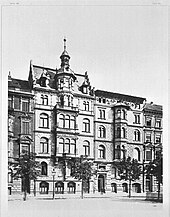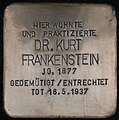Kurt Frankenstein
Kurt Frankenstein (born October 17, 1877 in Landeshut ; died May 16, 1937 in Bonn ) was a German gynecologist , obstetrician and surgeon .
Life
Kurt Frankenstein was born in 1877 as the youngest of three children of Louis Frankenstein from Landeshut and his wife Hulda. After graduating from school, he began studying medicine and specialized in gynecology and obstetrics. He received his doctorate in Munich in 1900 with the topic "On the construction of the normal uterine mucosa" . After completing his doctorate, he completed two years of military service and then worked as the first assistant at the University Clinic in Kiel .
In 1907 he got a job as chief physician at the gynecological clinic in Cologne-Kalk . He published his research results regularly, including in the monthly for obstetrics and gynecology, in the Wiener Medizinische Wochenschrift , in the Deutsche Medizinische Wochenschrift , the Zentralblatt für Chirurgie , in the Nederlands tijdschrift voor geneeskunde or the Zentralblatt für Gynäkologie. Around 1910 he converted to the Protestant faith and was baptized.
In October 1913 he married Susanne Margarethe Edel from Berlin in Cologne . Their son Joachim was born one year later, and their daughter Maria in 1919.
In the First World War he was drafted into military service. For his services in the field he received several military awards, including the Iron Cross 2nd class . Kurt Frankenstein was released from military service as a medical officer in the reserve.
After the end of the First World War he went back to Cologne and continued his professional activity in the Evangelical Hospital in Kalk . After the National Socialists came to power , the hospital management asked him on May 3, 1933 to submit his discharge. The reason for the request was that "one can not oppose the current trend without harming the interests of the hospital" . Despite Frankenstein's reply that he had been baptized as a Protestant , received military awards in the First World War and was employed in an institution of the Protestant Church, so that the provisions of the law on the restoration of the civil service passed on April 7, 1933 cannot be applied to him , he was released. Frankenstein's objection to his dismissal at the Evangelical Oberkirchenrat in Berlin and the General Superintendent of the Rhenish Provincial Church was unsuccessful.

The job opportunities for doctors of "non-Aryan descent" were increasingly restricted, health insurance companies no longer reimbursed bills, so that the doctors were dependent on private patients. Kurt Frankenstein set up a private practice in the residential building at Kaiser-Wilhelm-Ring 24, where he practiced until his death. He died of sepsis at the age of 59 on May 16, 1937 in Bonn and was buried on May 22, 1937 in Cologne's Westfriedhof .
Kurt Falkenstein was an active member of the Schlaraffia from 1912 . As a knight Pantopon the Wehwütige he was the Upper Schlaraffe of the Interior, Knight of Honor of the high Reyches Elberfeldensis and founder of the Pantopon tankards in Cologne and Wuppertal . In 1933 he was expelled from the Schlaraffia Colonia Agrippina together with the other 13 Jewish members . He was involved in the association of non-Aryan Christian front fighters . In June 1934 he took over the management of the Cologne group of this association.
Commemoration
In front of the former residential building at Kaiser-Wilhelm-Ring 24, which also housed Kurt Frankenstein's medical practice after 1933, in September 2018 in the presence of numerous members of the Schlaraffia in memory of the doctor and his wife Susanne Margarete, who perished in Theresienstadt in 1943 , his daughter Maria and son Joachim laid four stumbling blocks as part of the art and monument project by Cologne artist Gunter Demnig .
On March 18, 2019, another stumbling block was laid in front of Kurt Frankenstein's former place of work, the Evangelical Hospital in Cologne-Kalk .
After Kurt Frankenstein's death, his widow had to give up the spacious apartment in Kaiser-Wilhelm-Ring and moved to a smaller apartment on Machabäerstrasse. The children managed to escape from Germany in 1939: the son and his wife emigrated to the USA via Scotland in 1939 , the daughter Maria fled to Great Britain . Another stumbling block was laid for them on March 18, 2019 in front of their former school, the Königin-Luise-Schule.
Susanne Frankenstein could not make up her mind to leave Cologne. She had to give up her apartment in 1942 and was sent to the Fort V camp in Müngersdorf . From here it was on the 15 June 1942 Theresienstadt ghetto deported , where she died on March 21 1943rd
Pictures of the Stolperstein laying in front of his home address Kaiser Wilhelm Ring 24
Works by Kurt Frankenstein (selection)
- On the construction of the normal uterine mucosa , dissertation, 1900
- About artificial bladder filling in gynecological operations, especially in laparotomies, as a means of preventing subsequent urinary retention and eliminating dead spaces in the pelvis , 1906
- On the importance of uterine resection in fibroids in maintaining menstruation after surgery , 1907
- About clinical experience with vaporization , 1908
- About complete closure of the vagina , 1908
- Critical remarks on the question of subcutaneous infusions in eclampsia , 1910
- On the current status of placenta previa therapy , 1911
- For incision in appendix operations , 1912
- On the instrumental dilation of the introitus vulvae , 1913
- A contribution to balloon treatment with animal bladders , 1914
- Subcutaneous application of peristalsis-promoting agents in post-treatment after gynecological laparatomies , 1915
- The influence of diseases on the growth of premature births from birth to 9 years of age , 1920
- Long-term consequences of a tube perforation of the uterus , 1929
- Practical Notes on the Pernoctone Question , 1932
Individual evidence
- ↑ a b c d Birte Klarzyk: On the current laying of a "stumbling block" . ( museenkoeln.de [accessed November 5, 2018]).
- ^ Britta Bopf: "Aryanization" in Cologne: the economic extermination of the Jews 1933–1945 . Emons, Cologne 2004, ISBN 3-89705-311-X , p. 52 .
- ^ Friedhelm J. Solbach: Chance find: ExLibris Frankenstein . In: Message from the German Exlibris Society eV Volume 1/2019 , 2019 ISSN 1860-3777 , S. 16 ff .
- ↑ Stolperstein for Rt Pantopon the Wehwütige . In: Schlaraffia Colonia Agrippina . September 10, 2018 ( jimdo.com [accessed November 5, 2018]).
- ^ Sigrid Lekebusch: Distress and persecution of Christians of Jewish origin in the Rhineland, 1933–1945: presentation and documentation . Rheinland-Verlag, Cologne 1995, ISBN 3-7927-1522-8 , p. 61 .
- ^ Commemorative sheet for Susanne Margarete Edel. Federal Archives, accessed on November 5, 2018 .
- ↑ Gunter Demnig laid 42 new stumbling blocks. report-k.de, accessed on November 5, 2018 (German).
- ^ Maria Wrist (née Frankenstein) - Queen Luise School | Municipal high school for boys and girls. Accessed March 31, 2019 .
- ↑ Susanne Frankenstein | Victim database. In: holocaust.cz. Retrieved November 5, 2018 (Czech).
| personal data | |
|---|---|
| SURNAME | Frankenstein, Kurt |
| BRIEF DESCRIPTION | German gynecologist, obstetrician and surgeon |
| DATE OF BIRTH | October 17, 1877 |
| PLACE OF BIRTH | State hat |
| DATE OF DEATH | May 16, 1937 |
| Place of death | Bonn |





